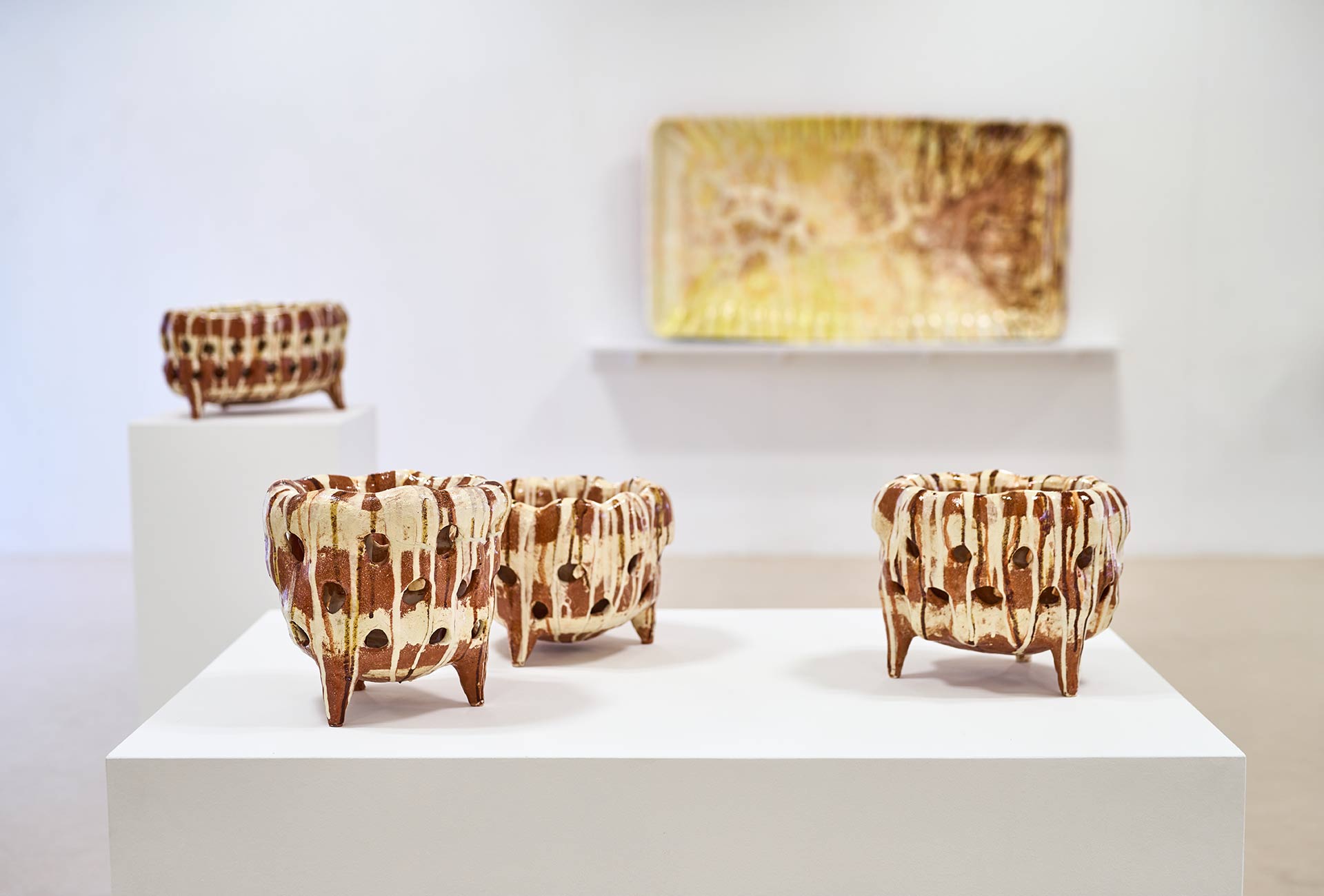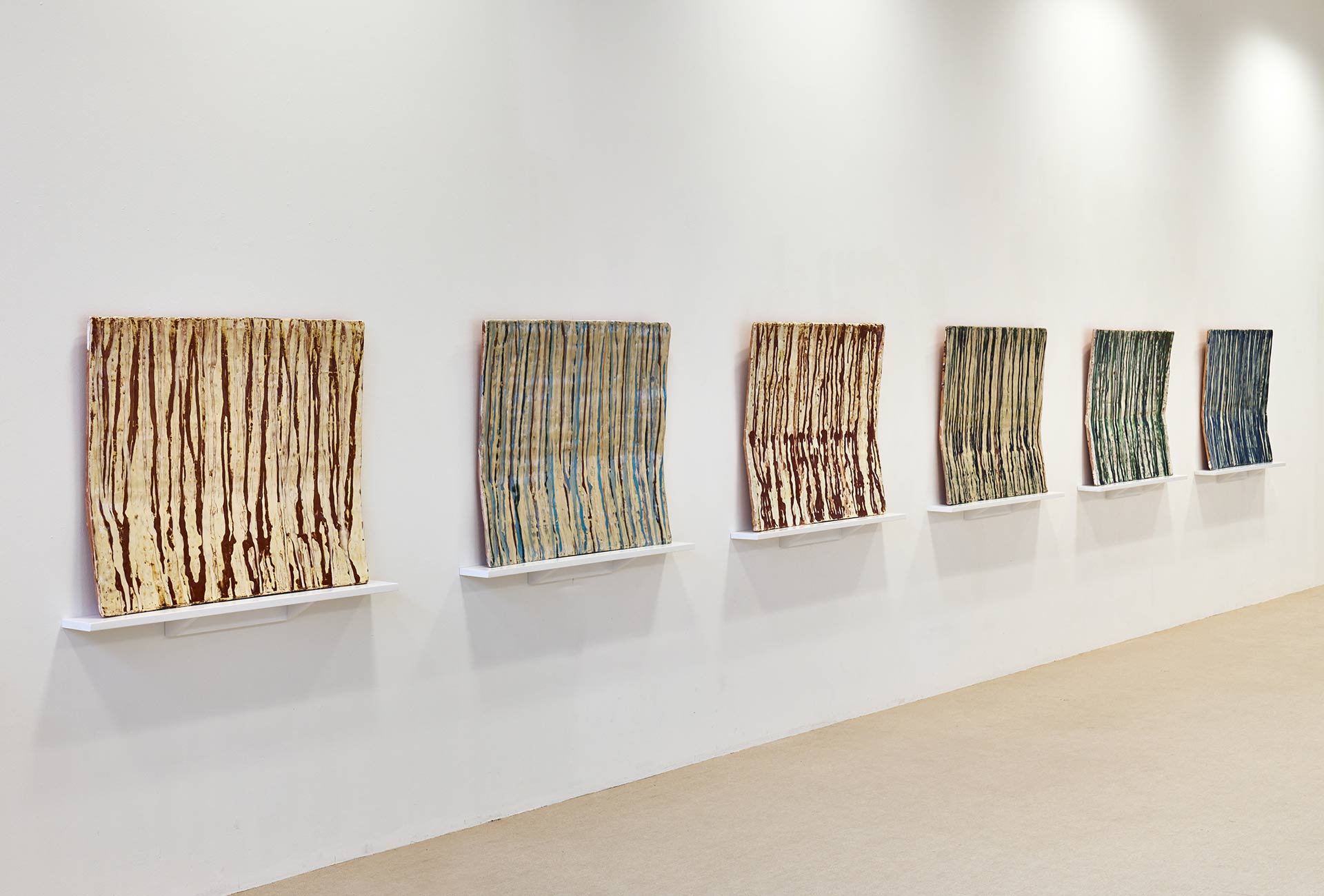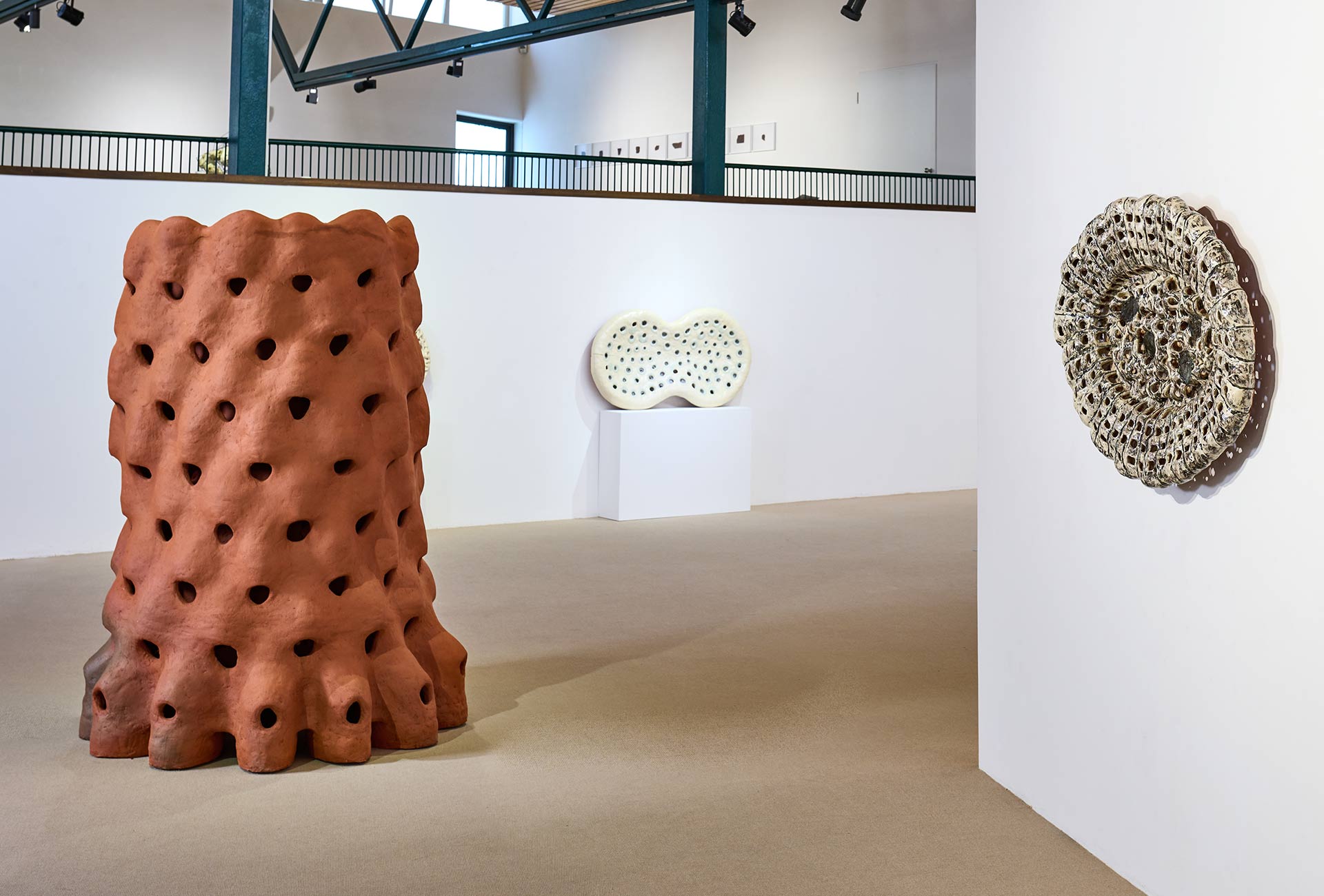A red-firing clay, which was used to make low-fired utilitarian wares, is found in southern Norway. Marit Tingleff consciously places herself in this tradition and uses the expressiveness of earthenware, which creates a feeling of closeness to the everyday thanks to its simplicity. She recognized early on that European earthenware held many possibilities for artistic exploration. Her encounter with the ceramics of the Danish architect and designer Thorvald Bindesbøll (1846-1908) was formative for her. The freely painted, abstract ornaments of his vessels inspired her to find her own language in this underestimated field of ceramics. As part of the Rhineland-Palatinate Summer of Culture under the motto “Compass Europe: Northern Lights,” the Ceramics Museum Westerwald is now exhibiting works by Marit Tingleff.

Marit Tingleff at the Ceramics Museum Westerwald. Doubles, 2018, in the background On the bright side, 2003. Photo Helge Articus.
Supported by women
Born in 1954, Tingleff studied at the Bergen University of Art and Design and headed the ceramics department at the Oslo Academy of Art [KhiO] from 2013 to 2016. Traditional, everyday, utilitarian ceramics serve as the starting point for her work. Tingleff enlarges plates, platters and bowls into powerful monuments, which thus become a tribute to the women who cared for their “good crockery” and proudly presented it on special occasions. “I want to honor all the hands that carried this dinnerware to the table and the same hands, often women’s hands, that washed these plates and put them away,” she says.
Marit Tingleff spontaneously paints the plates freehand with colored engobes. In doing so, she uses an insight from modern painting, in which the ornament emerges from the action. The large dimensions of the substrate liberate the act of painting, with the brushstrokes emerging not from the wrist but from the body. Tingleff washes the speckled, poured and painted layers of slip off the wet clay several times so that a sensuous painting gradually emerges through this rhythmic process. The colorful, curving lines and fields of color symbolize the intertwining of the many stories told at kitchen tables.

Marit Tingleff Standing Tiles. Photo Helge Articus.
Landscape
The Nordic landscape also plays a significant role in Tingleff’s work. She chose early on not to use imported clay, but only local raw material. She incorporates her observations of nature’s patterns or color moods into landscape paintings, thus internalizing the outside world, addressing sublime experiences of nature, but also pointing to environmental catastrophes in some of her works.
Her largest pieces were only feasible with clay from the Westerwald, so she visited the deposits of the Goerg & Schneider company in 2016 and personally selected the material. The resulting series consists of four large-scale, trough-like forms, which are on display in the exhibition. Maximizing the ceramic image space opens a panorama of four different color experiences in the landscape.

Marit Tingleff Sea cold, Growth, Light earth, Dark, 2017. From the Sea cold and Growth collection Nasjonalmuseet Oslo. Photo Helge Articus.
Earthly things
Another workgroup are her double-walled objects, which are only very remotely reminiscent of kitchen utensils such as teapots or strainers. Here, the doubling does not emerge from multiple layers of paint or hints of table culture, but is autonomously embodied in three dimensions. These enigmatic forms prompted the Danish art critic Poul Erik Tøjner to call them “Tingleffs” – because the first syllable of her last name means “thing” in Norwegian, making it perhaps the best way to describe these mysterious works. They are double-walled, but not imbued with double meanings, and they reject the question of their relevance. Hitherto unknown, they have now taken their rightful place in the Ceramics Museum. Especially at a time when encounters occur only digitally and the haptic definitely comes up short, we can enjoy these wonderful earthen things all the more.

The exhibition Irdene Dinge [Earthen things] shows objects by Marit Tingleff, inspired by fired commodities. Photo Helge Articus.
Accompanying program
Due to the current situation, unfortunately no in-person vernissage can take place. Two accompanying events are planned for the summer, for which you can register at kontakt@keramikmuseum.de.
View into our landscape, in cooperation with the Arbeitsgemeinschaft Westerwald-Ton e.V. (date to be announced). Marit Tingleff traveled to Westerwald in 2016 to select the raw material for her works. This event focuses the gaze on our unique landscape. Museum director Dr. Nele van Wieringen leads the tour of the exhibition. This will be followed by an excursion to the Westerwald clay deposits, where visitors will learn about modern, sustainable clay extraction with due regard for nature conservation.
A look inside grandma’s china cabinet, with Dr. Christian Lechelt on July 24, 2021, from 2 to 5 pm. Marit Tingleff addresses in a very personal way the rituals and table culture that involve the use of porcelain and ceramics. Visitors can have their “good piece” from grandma’s cupboard examined by porcelain specialist Dr. Christian Lechelt, director of the Museum Schloss Fürstenberg. In this way, they can learn more about the manufacturer and design of their heirloom.
- —
-
Ceramics Museum Westerwald
Lindenstrasse 13
56203 Höhr-Grenzhausen
Germany - Link